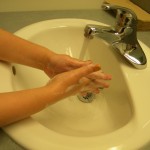by Ginny Hinton | May 12, 2014

New bill would require booster seats for children four years old through age five.
For several years, Florida has been the most dangerous state for children between the ages of 4 and 10 traveling in vehicles. Florida is currently one of only two states in the nation that lacks a booster seat bill for older children – and the only state that allows 4-year-olds to ride in an adult seatbelt.
Booster seats are needed for the simple reason that seat belts are designed to fit adults – specifically the “average” adult male. When a child under age 8 (on average) or under 4’ 9” tall and 80 pounds sits in an adult seatbelt, the lap belt tends to ride up onto his or her stomach. In a crash the belt tightens to keep the child from being ejected. It cuts through the soft stomach and the first bone to stop it is the spinal cord. This is known as “seat belt syndrome”. It can cause severe injuries including internal bleeding and even paralysis. A booster seat “boosts” the child up about six inches so the belt fits below the stomach and can restrain the child properly without causing injury. Using a booster seat reduces your child’s risk of injury by about 60%.
In Florida, some kids are about to get a safety “boost”. The Florida House and Senate just passed the revisions to Florida Statute 316.613 with Bill 225. If signed by Governor Scott, the new regulations will take effect on January 1, 2015. The new law will require children aged 4 through 5 years old to travel in a car seat or booster, NOT an adult seat belt. Unpaid drivers who are not in the child’s immediate family, children being transported for medical emergencies and children with a medical condition necessitating an exception are exempt from the law.
While this law by no means provides adequate protection for Florida’s older children, it is at least a step in the right direction. By a slim margin, Florida will no longer be the most unsafe state in the nation for child passengers.
by Ginny Hinton | Mar 17, 2014

Moderation is the key with both sugar and sugar substitutes.
Do you use sugar, honey, artificial sweetener, or some combination of them all? Which are better to use? The internet is flooded with myths about sweeteners – both nutritive and low- or no-calorie. Because it’s often difficult to sift through the claims, here’s a quick primer on sweeteners:
There are two types of sugar in American diets. Naturally occurring sugars are found in milk and fruit. Added sugars include any sweeteners with calories that are added to foods or beverages during preparation. One of today’s biggest culprits for added sugar is carbonated soda. Because added sugars contribute extra calories with zero nutrients, the American Heart Association recommends that everyone try to limit the amount of added sugars in their diet. One way to do that is by using artificial sweeteners.
Artificial or non-nutritive sweeteners are often used for weight control or diabetes management. Because they aren’t carbohydrates, these sweeteners don’t raise blood sugar levels. Approved non-nutritive sweeteners have to pass rigorous government safety assessments before being accepted for sale. They can be safely consumed by the general public and do not cause or increase the risk of cancer or other health conditions. They may help with weight management when used as part of a sensible meal plan. Many rigorous studies support the safety of various non-nutritive sweeteners, including over 200 studies on aspartame alone.
High fructose corn syrup is a sweetener made from corn starch. It has the same calories per tablespoon and very similar effects on blood levels as sugar. Honey is a caloric, or nutritive, sweetener that is often promoted as a healthier option than table sugar or sugar substitutes. Its vitamin and mineral content is actually very similar to sugar and both sugar and honey end up in the body as glucose and fructose.
The bottom line is that moderation is the key with both sugar and sugar substitutes. It’s important with sweeteners to look beyond the hype. In the end any processed foods, with or without sugar substitutes, generally don’t offer the same health benefits you get from foods like fruits and vegetables.
References:
Mayo Clinic Staff, Artificial Sweeteners and Other Sugar Substitutes (October 9, 2012). http://www.mayoclinic.com/health/artificial-sweeteners?MY00073
Junod, Suzanne W., Sugar: A Cautionary Tale (May 21,2009). http://www.fda.gov.
CFSAN/Office of Food Additive Safety, FDA Statement on European Aspartame Study (April 20, 2007). http://www.fda.gov
International Food Information Council Foundation, Facts About Low-Calorie Sweeteners, (August 2012). www.foodinsight.org.
American Diabetes Association, Artificial Sweeteners (February 16, 2011). www.diabetes.org/food-and-fitness/
Food and Drug Administration, High Fructose Corn Syrup: Questions and Answers (April 17, 2013). http://www.fda.gov
Hirsch, Larissa, Are Artificial Sweeteners OK to Consume During Pregnancy? (August 2009). http://kidshealth.org
Low Calorie Sweeteners Webinar powerpoint (2011). https://connect.extension.iastate.edu/fffcop?launcher=false.
American Heart Organization, Non-Nutritive Sweeteners (Artificial Sweeteners) (December 13, 2012). http://www.heart.org?HEARTORG
by Ginny Hinton | Dec 4, 2013
Normal
0
false
false
false
EN-US
X-NONE
X-NONE
/* Style Definitions */
table.MsoNormalTable
{mso-style-name:”Table Normal”;
mso-tstyle-rowband-size:0;
mso-tstyle-colband-size:0;
mso-style-noshow:yes;
mso-style-priority:99;
mso-style-parent:””;
mso-padding-alt:0in 5.4pt 0in 5.4pt;
mso-para-margin:0in;
mso-para-margin-bottom:.0001pt;
mso-pagination:widow-orphan;
font-size:11.0pt;
font-family:”Calibri”,”sans-serif”;
mso-ascii-font-family:Calibri;
mso-ascii-theme-font:minor-latin;
mso-hansi-font-family:Calibri;
mso-hansi-theme-font:minor-latin;}

Wash your hands with soap and water for at least 20 seconds to reduce the spread of germs.
It seems like such a simple solution. Wash your hands to keep yourself well during this cold and flu season. Unfortunately, even though most people know how important hand washing is, many still don’t follow important hygiene procedures. What do we need to do – and teach our kids to do – to stay well this fall and winter? The answer is: wash frequently and correctly.
Our bodies are covered with bacteria. Some cause disease, while others are actually helpful. Some stay on our skin all the time, while we pick up others through contact with objects such as doorknobs, handles, keyboards, and phones. Those “transient” bacteria and viruses that we pick up can live up to five hours on dry surfaces. Touch your cell phone or scratch an itchy eye and they’re now living in your body!
A study conducted by Russell Research for the American Cleaning Institute® (www.cleaninginstitute.org) found that, even though an overwhelming 97% of parents and children agree that hand washing is one of the most important things they can do to keep from getting sick, they don’t always follow through on that belief. At home, only 66% of parents say they have taught their children to spend 20 seconds washing their hands and a full 33% of parents admitted to not always washing their own hands after leaving the restroom. While many parents have discussed the importance of hand washing with children, the research indicates that they must lead by example and prompt kids every day if the message is going to stick.
The way you wash your hands is just as important as the fact that you wash them at all. Just rinsing them for a couple of seconds and then drying them off helps very little. Soap is important to break up grease and dirt, which can hide thousands of germs. Antibacterial soap isn’t necessary unless you’re a surgeon. Any soap that lathers will work. Wet your hands, soap up, and scrub your hands together vigorously. It’s the friction you create that removes the viruses. Take your time to be sure you’ve removed all the germs. The CDC recommends at least 20 seconds of hand washing. Although that doesn’t sound like a long time, it’s probably much longer than you think. Time yourself the next time you wash your hands. Watch your child to make sure he or she is practicing good hygiene. Remind him or her daily about hand washing because it matters. Get your family in the habit of washing their hands before and after caring for someone who is sick, before and after treating a cut or wound, and after blowing their nose, coughing, or sneezing. Lessons learned at home last a lifetime!
Source: http://www.cdc.gov/handwashing/
by Ginny Hinton | Jun 5, 2013

The proper seat correctly installed helps keep children safe.
Dawson is a healthy, active 3-year-old whose mom makes sure he eats right, learns something new every day, and rides safely in the car. Until a few months ago, Dawson, who weighs 42 pounds and is 42 inches tall, traveled in a booster seat. When his mom learned that, because of his age, Dawson would be safer in a 5-point harness, she moved him to a safer car seat and made sure it was installed correctly. Just a few weeks ago, Dawson was riding in the car with relatives when someone drove in front of them and caused a 45 mph crash, totaling both cars. One of the adults fractured her collarbone; another suffered a concussion. Dawson bit his tongue and was really scared – but he was unhurt. Dawson’s mom says she is truly thankful she put him in the correct car seat. Because car seats are made to survive only one crash, she has already replaced his old seat and Dawson continues to travel safely in the car.
Dawson’s story can happen to any child. It’s important that every parent know how to keep their children safe on the roads. Here are some quick pointers to keep children safe at every age:
- All infants and toddlers should ride in a Rear-Facing Car Seat until they are 2 years old or until they reach the highest weight/height allowed by the manufacturer. Rear-facing is the safest way to travel!
- Children 2 years to at least 4 years old and 40 pounds should use a Forward-Facing Car Seat with a harness for as long as possible. Keeping a child who weighs more than 40 pounds in a harness is the safest practice, as long as the seat’s weight limits are followed.
- Children whose weight or height is above the forward-facing limit for their car seat should use a Belt-Positioning Booster Seat until the vehicle seat belt fits properly, typically when they are at least 4 feet 9 inches tall and are between 8 and 12 years old. Children using a booster seat should be able to sit reasonably still for an entire trip.
- Children who are old enough and large enough to use the vehicle seat belt alone should always use both Lap and Shoulder Belts for the best protection. Children younger than 13 years should sit in the back seat.
Certified Child Passenger Safety Technicians (CPSTs) are trained to help caregivers make sure their children are traveling safely. Find a CPST near you at http://cert.safekids.org.
by Ginny Hinton | Mar 21, 2013
 “Fat” is probably one of the most dreaded words in our culture. While our eyes may light up when we smell a juicy steak or see an apple pie, we’re warned to steer clear of those tempting foods before they leave a deposit – right around our waistlines. But wait. Isn’t some fat good for our bodies? Because navigating through the wealth of nutritional information available today can be tough, here’s a primer about the role of fat in good health. Just call it “Fat 101”.
“Fat” is probably one of the most dreaded words in our culture. While our eyes may light up when we smell a juicy steak or see an apple pie, we’re warned to steer clear of those tempting foods before they leave a deposit – right around our waistlines. But wait. Isn’t some fat good for our bodies? Because navigating through the wealth of nutritional information available today can be tough, here’s a primer about the role of fat in good health. Just call it “Fat 101”.
Our bodies need fat in order to work right. Fat gives us energy and helps us absorb vitamins. It protects our internal organs from injury. Without fat, we wouldn’t grow properly or stay healthy. At the same time, at 9 calories per gram compared with about 4 calories per gram in protein or carbohydrates, fat is very high in calories. So, how do we know when to choose fat and when to stay away?
The answer lies in what kind of fat and how much of it we eat. Healthy fats are unsaturated, which means they stay liquid at room temperature. A form of unsaturated fat that is especially heart healthy and can even help lower high triglycerides in our blood is omega-3 fatty acid. “Omega-3s” can be found in fish like salmon, sardines, albacore tuna and rainbow trout. They are also in soybean products, walnuts, flaxseed and canola oil. While omega-3s are no “magic bullet”, they do offer health benefits throughout our lives. Studies have shown that omega-3s can help prevent some types of heart disease, lower triglycerides, reduce chronic inflammation, and promote healthy aging.
Unfortunately, the typical American diet is low in omega-3s. In fact, it’s estimated that only 25% of us consume any omega-3s on most days. That’s partly because the typical American diet involves eating a lot of fast food that contains high amounts of saturated fat and little to no omega-3s. Fortunately, fish oil or flaxseed oil can be purchased as an over-the-counter supplement for those who don’t eat many foods that are high in Omega-3s.
So, the verdict is in. Omega-3s are an important type of fat found mainly in fish and fish oil supplements. These special fatty acids are a necessary part of a diet promoting overall health and fighting heart disease. While all fats are high in calories and should be consumed sparingly, these are the best of the lot and come with exciting benefits that can help us live a longer and healthier life.





